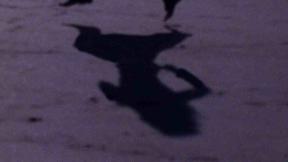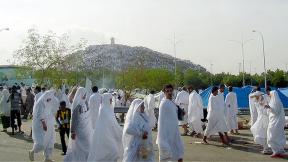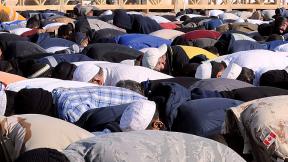
Hajj is one occasion where Muslims have an opportunity to share information about not just a religious rite of Islam, but also the story of three prominent figures in the histories of Islam, Judaism and Christianity: Prophet Ibrahim (peace be upon him), Hajira (may Allah be pleased with her) and Prophet Ismail (Peace be upon him).
There are other reasons why parents should do this.
One is that your child and Muslim children feel less awkward identifying themselves as Muslims after someone in an authority position has discussed clearly what they believe in, and why.
As a result, your child, and other Muslim children in the class, if there are any, are likely to feel more confident and secure.
The second reason is that Muslim children need to feel the importance of their own traditions, especially since we are living in a non-Muslim environment where kids don't see regular reminders of Islam or its important traditions and celebrations.
The third reason is that talking to your child's class about Hajj is a great way to make Dawa to non-Muslim kids and Muslim kids as well, in particular those who may come from non-practicing Muslim families.
There are a couple of tips to keep in mind when approaching the school or your child's teacher about presenting, as well as for how you present the information to the child's class.
1. Start early
Begin with Bismillah and make your intention for the sake of Allah.
Remember that calling your child's teacher on the 9th of Zil Hajj asking to do a presentation on Hajj is too late. Now, with more than a month before Hajj is the best time to bring up the issue.
Starting early also helps you think about and gather the right materials to make a good presentation.
2. Get permission from your child's teacher
While parents do have a lot of clout in the public school system, this does not allow them to show up unexpectedly one day at their son or daughter's class to do a presentation on Hajj.
Send a letter (see a sample letter for a similar request) giving a general indication that you want something done about Hajj. Then wait for the teacher to call. If he or she does not do so within a week, call them and tell them you are following up on the letter you sent earlier.
3. Select the right period in which to do the presentation
Does your child study Social Studies? Or does he or she have a period once a week for Moral and Religious education? If so, suggest to the teacher that you would like to do the presentation during these periods. Or, you can ask the teacher if he or she has ideas about which time would be best to come in and do the presentation.
4. Be polite but firm
Speaking nicely to people, including non-Muslims, is part of our Deen. We should remember that the purpose of this exercise is to not just educate the students, but the teachers as well. Being polite and courteous will not detract from your desire to present. It will serve to build bridges and communication, and could lead to further contact to do presentations on other Islam-related topics and more teacher-parent cooperation in the future, Insha Allah.
5. Ask the teacher what areas to cover and how long it should be
This helps to adjust your presentation to the age level of the students, as well as connect it to what they are already learning. This doesn't mean you can't bring in other information, but knowing what to cover from the teacher helps you put down what has to be covered and from there you can develop more points on these or related topics.
Asking how long the presentation should be can also help you decide how much you can include in your presentation.
6. Read, prepare, read, prepare
Now that you've gotten the permission, don't just sit back and wait for the night before the presentation to put it together.
Do lots of reading and researching from good sources. The more you read and look for material, the more you have to pick from, which will, insha Allah, help your presentation look better.
Preparing is important, even though you may have learned about Hajj way back when and may have even gone yourself. Get a children's Islamic book and read what it says about Hajj. Or an article written by a teenager about Hajj. This will also help you understand what points to emphasize in your presentation.
Reading up will also clarify any incorrect cultural norms that may have seeped into the practice of Hajj which you may not have been aware of. Talk to a scholar or a knowledgeable Muslim for advice as well.
7. Get someone who's gone for Hajj to talk about it
This is more effective than someone who can speak well and show great pictures, but who hasn't experienced the real thing. But you can use both. If you have not gone but can find someone willing to share their experience, both of you can present. Ideally, the person should be a great storyteller. But ask the teacher's permission to bring in a second person, just in case.
8. Use lots of video and pictures
If you want to appeal to the students, especially younger ones, you are going to need more than just a talk. Visuals are a great help.
You can get a Hajj video and pictures of Muslims at Hajj, for instance.
If the class is made up of children grades kindergarten to four, showing them a part of Adam's World 4, Take me to the Kaba, can explain Hajj in a simple and interesting way for them.
To get the right material, you will have to find out where to get it from, and ordering it might take a couple of weeks.
9. Get a 3-D model of the Kaba
Better yet, build one, or get a handyman (or woman) spouse, relative or friend to do it. Include as many details of the Kaba and the Haram ash Shareef as possible. Then, once it's done, use one of your kids' action figures, dressed in Ihram, to demonstrate the rites of Hajj.
Use an action figure which most of them would be familiar with. To find out which to use, use the next tip.
10. Talk to your son or daughter about the presentation
Who would better understand what interests kids in the class than your son or daughter? Consult them about what to include, what the kids like, what kind of things they are interested in. Not only will this improve your presentation, Insha Allah, but it will also make Ameena or Saeed feel important and more confident as individuals, and as Muslims.
11. A few days before the presentation
Call the teacher to check the date and time of the schedule. This will serve to remind him or her about your visit and prepare the class accordingly. It will also help you double check the exact time and date.
12. Write presentation points on note cards
Reading off papers will not hold the interest of many people, young or old. Instead, writing brief notes on note cards that you can look at so you don't miss any topic will help you avoid straying from the subject while allowing you to make eye contact with your audience and keeping a conversational style of presentation.
13. Practice your presentation in front of your son/daughter
Practicing helps you identify what can be improved, changed or omitted. Practicing in front of Ameena will give you the opportunity to present before one of the kids in the class who can really give you the best advice. It will also help you time your presentation, so you can make it shorter or longer.
14. Dress in Ihram
This of course may depend on the weather for brothers. Maybe you can wear it over your clothes to show the class. Dressing in Ihram will also save you time in explaining how Ihram is worn.
If you decide not to wear the Ihram as an example, dress well. This does not mean pulling out the Armani suit or the most expensive dress you have. It just means looking as a Muslim should-clean, respectable, professional and Islamically covered. Clothes don't always "make the man" but they do affect others' perception of you.
15. Get there early
Teachers and students are busy people. They have a certain curriculum to cover. The fact that they've squeezed in your presentation is somewhat of a privilege. Don't take advantage of this by wasting their time and coming late. And Muslims should be on time as a principle anyway.
Coming early can also help you properly set up your audio and/or visual material.
16. Make Dua...
before your presentation. Ask Allah to help you convey this message sincerely, properly and clearly. And say Bismillah.
17. Speak calmly and clearly
It's important not to race through the presentation, nor to talk too slowly. A clear, conversational style, with emphasis on the major points or terms you want the students to understand can help convey the message properly.
18. Show more than you tell
"Show and tell" is a game a number of children play in school at the early grades. It helps kids develop language and communication skills.
In your case, if you have enough audio/visual material, showing and telling becomes easier.
But there should be more emphasis on showing than telling. Showing is facilitated by your model of the Kaba when you show how pilgrims do the Tawaf, for instance. Or by showing part of Take Me To The Kaba, which explains the importance of Hajj.
Showing allows for a better opportunity for the retention of information than telling does.
19. When answering questions
If you don't know something, say so. Then check up on it and get back to the teacher. Ask him or her to convey the response.
20. Thank Allah...
for this opportunity He blessed you with and your ability to go through with it.
21. Send a thank you note to the teacher and class...
thanking them for their time and attention, as well as their cooperation.








Comments
Some great advice, but the links you have mentioned are non available. I will be doing an hajj assembly - they would be very useful if they were available.Could you suggest any other hajj videos for non muslim children - as they are my audience! Needs to be KS2 (Age 7-9) friendly.Thanks in advance
Location
asalaam alaikum, this is a good article but we need more detail to on how to explain the purpose of hajj to a secular public school in a way that wont get us in trouble by discussing religion, but not taking away from the purpose of hajj to worship Allah. also if not explained carefully they may be lead to believe that the kaaba is what we worship, rather than a focul point in terms of direction to signify unity amongst muslims.
Location
I wish if you gave me ideas for art and craft to do on class
Location
Add new comment